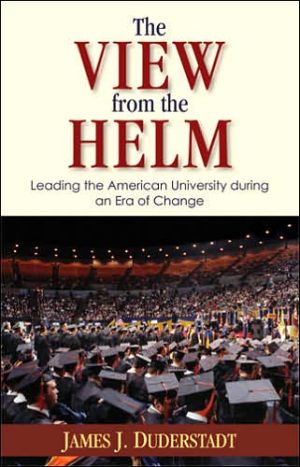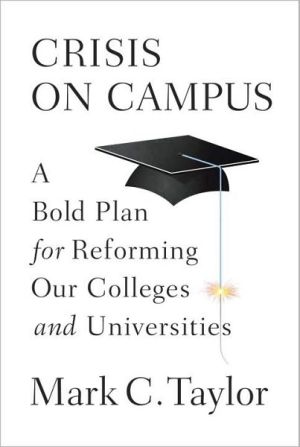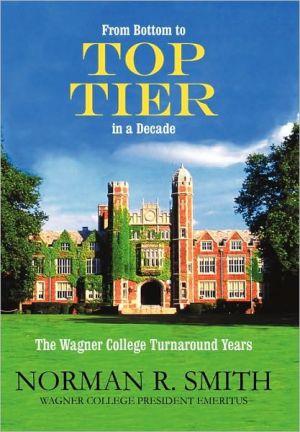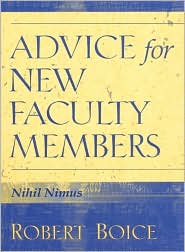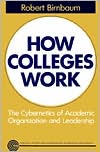The View from the Helm: Leading the American University during an Era of Change
Widely regarded as one of the most active and publicly engaged university presidents in modern academia, Duderstadt—who led the University of Michigan from 1988 to 1996—presided over a period of enormous change, not only for his institution, but for universities across the country. His presidency was a time of growth and conflict: of sweeping new affirmative-action and equal-opportunity programs, significant financial expansion, and reenergized student activism on issues from apartheid to...
Search in google:
Widely regarded as one of the most active and publicly engaged university presidents in modern academia, Duderstadt—who led the University of Michigan from 1988 to 1996—presided over a period of enormous change, not only for his institution, but for universities across the country. His presidency was a time of growth and conflict: of sweeping new affirmative-action and equal-opportunity programs, significant financial expansion, and reenergized student activism on issues from apartheid to codes of student conduct.Under James Duderstadt’s stewardship, Michigan reaffirmed its reputation as a trailblazer among universities. Part memoir, part history, part commentary, The View from the Helm extracts general lessons from his experiences at the forefront of change in higher education, offering current and future administrators a primer on academic leadership and venturing bold ideas on how higher education should be steered into the twenty-first century.
\ THE VIEW FROM THE HELM\ \ Leading the American University during an Era of Change \ \ \ \ By JAMES J. DUDERSTADT \ The University of Michigan Press \ Copyright © 2007 \ \ University of Michigan\ All right reserved.\ \ \ ISBN: 978-0-472-11590-7 \ \ \ \ \ Chapter One THE LEADERS AND BEST \ The beginning of a new university presidency is usually associated with the pomp and circumstance of an academic inauguration ceremony. The colorful robes of an academic procession, the familiar strains of ritualistic music, and the presence of distinguished guests and visitors all make for an impressive ceremony, designed to symbolize the crowning of a new university leader. Of course, like most senior leadership positions, the university presidency takes many forms depending on the person; the institution; and, perhaps most significant, the needs of the times. Clearly, as the chief executive officer of an institution with thousands of employees (faculty and staff) and clients (students, patients, sports fans), an annual budget in the billions of dollars, a physical plant the size of a small city, and an influence that is frequently global in extent, the management responsibilities of the university president are considerable, comparable to those of the CEO of a large, multinational corporation.\ A university president is also a public leader, with important symbolic, political, pastoral, and at times even moral leadership roles, particularly when it comes to representing the institution to a diverse array of external constituencies, such as government, business and industry, prospective donors, the media, and the public at large. The contemporary university is a political tempest in which all the contentious issues swirling about our society churn together: for example, civil rights versus racial preference, freedom of speech versus conflicting political ideologies, social purpose versus market-driven cost-effectiveness. It is of little wonder that today's university president is frequently caught in the cross fire from opposing political points of view, making the presidency of a major university both considerably more difficult and less attractive now than in earlier eras.\ My service on various advisory committees and as understudy to two earlier Michigan presidents had provided a rigorous education on the nature of the contemporary university presidency prior to my ascent-or perhaps descent, in the minds of some-to this leadership role. It was therefore perhaps not surprising that on that beautiful fall day in October 1988, my wife, Anne, and I approached my inauguration as Michigan's eleventh president with considerable apprehension. We viewed even the terminology used to describe the inauguration event, the "installation" of a new president, as suggestive more of bolting one into the complex machinery of the university administration than of coronating a new leader. Yet we also viewed this opportunity to serve our university as both a great privilege and a very considerable responsibility. Fortunately, after two decades at Michigan, we were well steeped in the legend and lore of the university, a very key requirement for a successful university presidency.\ INSTITUTIONAL SAGA\ Successful university presidents must be well informed (acclimated or indoctrinated) to the history, traditions, and cultures of the institutions they are leading. The way that academic institutions respond to changes in leadership is very different than, for example, the way that the federal government adapts to a new president or the way that a corporation is reshaped to accommodate a new CEO. Universities are based on long-standing traditions and continuity, evolving over many generations (in some cases, even centuries), with very particular sets of values, traditions, and practices.\ Burton R. Clark, a noted sociologist and scholar of higher education, introduced the concept of "organizational legend," or "institutional saga," to refer to those long-standing characteristics that determine the distinctiveness of a college or university. Clark's view is that "[a]n organizational legend (or saga), located between ideology and religion, partakes of an appealing logic on one hand and sentiments similar to the spiritual on the other"; that universities "develop over time such an intentionality about institutional life, a saga, which then results in unifying the institution and shaping its purpose." Clark notes: "An institutional saga may be found in many forms, through mottoes, traditions, and ethos. It might consist of long-standing practices or unique roles played by an institution, or even in the images held in the minds (and hearts) of students, faculty, and alumni. Sagas can provide a sense of romance and even mystery that turn a cold organization into a beloved social institution, capturing the allegiance of its members and even defining the identity of its communities."\ All colleges and universities have a social purpose, but for some, these responsibilities and roles have actually shaped their evolution and determined their character. The appearance of a distinct institutional saga involves many elements-visionary leadership; strong faculty and student cultures; unique programs; ideologies; and, of course, the time to accumulate the events, achievements, legends, and mythology that characterize long-standing institutions. For example, the saga of my alma mater, Yale University, was shaped over the centuries by old-boy traditions, such as secret societies (e.g., Skull and Bones); literature (from dime-novel heroes, such as Frank Merriwell and Dink Stover, to Buckley's God and Man at Yale); and national leadership (William H. Taft, George H. Bush, Bill Clinton, George W. Bush, and Gerald R. Ford-although the latter was first and foremost a Michigan man). Harvard's saga is perhaps best captured by the response of a former Harvard president who, when asked what it takes to build a great institution like Harvard, responded simply, "Three hundred years!" Notre Dame draws its saga from the legends of the gridiron, that is, Knute Rockne, the Four Horsemen, and the Subway Alumni. Big Ten universities also have their symbols: fraternity and sorority life, campus protests, and gigantic football stadiums.\ While institutional sagas are easy to identify for older universities (e.g., North Carolina, Virginia, and Michigan among the publics; Harvard, Yale, and Princeton among the privates), they can sometimes be problematic to institutions rising rapidly to prominence. During the controversy over inappropriate use of government research funds at Stanford during the 1990s, the late Roger Heyns-former Michigan dean; chancellor at the University of California, Berkeley; and then president of the Hewlett Foundation, adjacent to the Stanford campus-once observed to me that Stanford faced a particular challenge in becoming too good too fast. Prior to World War II, its reputation as "the farm" was well deserved. Stanford was peaceful, pastoral, and conservative. The extraordinary reputation it achieved first in the sciences and then across all the disciplines in the latter half of the twentieth century came on so abruptly that the institution sometimes found it difficult to live with its newfound prestige and visibility, as its inquisition by a congressional inquiry into misuse of research funds in the 1990s demonstrated.\ Again I quote Burton Clark: "The institutional saga is a historically based, somewhat embellished understanding of a unique organization development. Colleges are prone to a remembrance of things past and a symbolism of uniqueness. The more special the history or the more forceful the claim to a place in history, the more intensively cultivated are the ways of sharing memory and symbolizing the institution." A visit to the campuses of one of our distinguished private universities conveys just such an impression of history and tradition. Their ancient ivy-covered buildings and their statues, plaques, and monuments attesting to important people and events of the past convey a sense that these institutions have evolved slowly over the centuries-in careful and methodical ways-to achieve their present forms and define their institutional saga. In contrast, a visit to the campus of one of our great state universities conveys more of a sense of dynamism and impermanence. Most of the buildings look new, even hastily constructed to accommodate rapid growth. The icons of the public university tend to be their football stadiums or the smokestacks of their central power plants, rather than ivy-covered buildings or monuments. In talking with campus leaders at public universities, one gets little sense that the history of these institutions is valued or recognized. Perhaps this is due to their egalitarian nature or, conversely, to the political (and politicized) process that structures their governance and all too frequently informs their choice of leadership. The consequence is that the public university evolves through geological layers, each generation paving over or obliterating the artifacts and achievements of its predecessors with a new layer of structures, programs, and practices. Hence, the first task of a new president of such an institution is that of unearthing and understanding its institutional saga.\ THE MICHIGAN SAGA\ To illustrate, let me adopt the perspective of a university archaeologist by sifting through the layers of the University of Michigan's history to uncover its institutional saga. Actually, this exercise is necessary both to explain my particular experience as a university president and to set the stage for a more in-depth analysis of the various elements of university leadership. So what might be suggested as the institutional saga of the University of Michigan? What are the first images of Michigan that come to mind? Academic activities such as students listening attentively to brilliant faculty in the lecture hall or studying in the library? Scientists toiling away late in the evenings in the laboratory, striving to understand the universe; or scholars poring over ancient manuscripts, rediscovering our human heritage? Not likely.\ The University of Michigan is many things to many people, but its images are rarely stimulated by its core missions of teaching and scholarship. To some, the university's image is its football team, the Michigan Wolverines, decked out in those ferocious winged helmets as it stampedes into Michigan Stadium before a crowd of 110,000, rising to sing the Michigan fight song, Hail to the Victors. Others think first of a Michigan of the arts, where the world's leading orchestras and artists come to perform in Hill Auditorium, one of the great concert halls of the world.\ For some, Michigan represents the youthful conscience of a nation-the birthplace of the teach-in protests against an unpopular war in Vietnam, site of the first Earth Day, and home of the century-old Michigan Daily, with student engagement in so many of the critical issues of the day. There is also the caring Michigan, as experienced by millions of patients who have been treated by the University of Michigan Medical Center, one of the nation's great centers of medical research, teaching, and clinical care.\ Then there is the Michigan of the cutting-edge research that so improves the quality of our lives. For example, it was at Michigan fifty years ago that the clinical trials were conducted for the Salk polio vaccine. It was at Michigan that the gene responsible for cystic fibrosis was identified and cloned in the 1990s. And although others may have "invented" the Internet, it was Michigan (together with another "big blue" partner, IBM) that built and managed the Internet backbone for the nation during the 1980s and early 1990s.\ Michigan can also be seen as a university of the world, long renowned as a truly international center of learning. If you walk down the streets of any capital city in the world, you will encounter Michigan graduates, often in positions of leadership. Indeed, Michigan is even a university of the universe, with the establishment of the first lunar chapter of the UM Alumni Association by the all-Michigan crew of Apollo 15.\ These activities may serve as images of the university for many. I would suggest, however, that they are less a conveyance of the nature of Michigan's institutional saga than a consequence of its more fundamental traditions and character. To truly understand Michigan's saga, one must go back in time almost two centuries ago, to the university's founding in frontier America.\ It can be argued that it was in the Midwest, in such towns as Ann Arbor and Madison, that the early paradigm for the true public university in America first evolved, a paradigm that was capable of responding to the needs of a rapidly changing nation in the nineteenth century and that still dominates higher education today. In many ways, the University of Michigan has been, throughout its history, the flagship of public higher education in America. Although the University of Michigan was not the first of the state universities, it was the first to be free of sectarian control, created as a true public institution, and responsive to the people of its state.\ The University of Michigan (or, more accurately, the Catholepistemead or University of Michigania) was established in the village of Detroit in 1817 (two decades before Michigan entered the Union), by an act of the Northwest Territorial government. It was financed through the sale of Indian lands granted by the U.S. Congress. The founding principle for the university can be found in the familiar words of the Northwest Ordinance, chiseled on the frieze of the most prominent building on today's campus, Angell Hall: "Religion, morality, and knowledge being necessary to good government and the happiness of mankind, schools and the means of education shall forever be encouraged." This precept clearly echoes the Jeffersonian ideal of education for all-to the extent of an individual's capacity-as the key to creating the educated citizenry necessary for a democracy to flourish.\ Actually, the first incarnation of the University of Michigan (the Catholepistemiad) was not a university but, rather, a centralized system of schools, borrowing a model from the imperial University of France founded by Napoleon a decade earlier. It was only after the state of Michigan entered the Union in 1837 that a new plan was adopted to shift the university beyond secondary education, establishing it as a "state" university after the Prussian system, with programs in literature, science, and arts; medicine; and law-the first three academic departments of the new university.\ Both because the university had already been in existence for two decades before the state of Michigan entered the Union in 1837 and because of the frontier society's deep distrust of politics and politicians, the new state's early constitution (1851) granted the university an unusual degree of autonomy as a "coordinate branch of state government," with full powers over all university matters granted to its governing board of regents (although, surprisingly enough, it did not state the purpose of the university). This constitutional autonomy, together with the fact that the university was actually established by the territorial government and supported through a land grant from the U.S. Congress, has shaped an important feature of the university's character. In financial terms, the University of Michigan was actually a U.S. land-grant university-supported entirely by the sale of its federal lands and student fees (rather than state resources)-until after the Civil War. Hence, throughout its history, the university has regarded itself as much as a national university as a state university, albeit with some discretion when dealing with the Michigan state legislature. This broader heritage has also been reflected in the university's student enrollment, which has always been characterized by an unusually high percentage of out-of-state and international students. Furthermore, Michigan's constitutional autonomy, periodically reaffirmed through court tests and constitutional convention, has enabled the university to have much more control over its own destiny than have most other public universities.\ Implicit in the new constitution was also a provision that the university's regents be determined by statewide popular election, again reflecting public dissatisfaction with the selection and performance of the early, appointed regents. (The last appointed board retaliated by firing the professors at the university.) The first assignment of the newly elected board was to select a president for the university (after inviting back the fired professors). After an extensive search, they elected Henry Philip Tappan, a broadly educated professor of philosophy from New York, as the first president of the reconfigured university.\ (Continues...)\ \ \ \ \ \ Excerpted from THE VIEW FROM THE HELM by JAMES J. DUDERSTADT Copyright © 2007 by University of Michigan . Excerpted by permission.\ All rights reserved. No part of this excerpt may be reproduced or reprinted without permission in writing from the publisher.\ Excerpts are provided by Dial-A-Book Inc. solely for the personal use of visitors to this web site.\ \
Contents Preface....................xiAcknowledgments....................xviiPART I. THE PATH TO THE PRESIDENCY....................11. The Leaders and Best....................3Institutional Saga....................4The Michigan Saga....................7A Heritage of Leadership....................17Michigan's Character as a Trailblazer....................29The Role of Institutional Saga in Presidential Leadership....................32The "What," "How," and "Who" of the University Presidency....................372. The Path to the Presidency....................39Tinker, Tailor, Soldier, Sailor; Rich Man, Poor Man, Beggar Man, Thief; ... and University President....................40The Academic Leadership Ladder....................44The Path to the Michigan White House....................48On to Michigan....................52Trapped in the Gravitational Pull of Academic Administration....................56On the Brink....................683. The Presidential Search....................71The Search Process....................72The Presidential Search: A Victim's Perspective....................76A Postmortem....................85Some Advice for Presidential Search Committees and University Governing Boards....................86Some Advice for Candidates for University Presidencies....................95So What Are We Supposed to Do Now?....................97PART II. PRESIDENTIAL LEADERSHIP....................1034. Presidential Leadership....................105The Elements of Presidential Leadership....................107Several Unique Aspects of UniversityLeadership....................111The Many Styles and Philosophies of Presidential Leadership....................116Adapting Leadership Styles to the Times and the Institution....................120A Matter of Personal Style....................124Movers and Shakers, Pushers and Coasters: The Impact of the Presidency....................128Leadership for a Time of Change....................1295. Executive Leadership....................132The Executive Officer Team....................135Go Downtown and Get the Money....................143Bricks and Mortar....................150Crisis Management....................154The Challenges of Executive Leadership....................1576. Academic Leadership....................162The Academic Clockwork....................164Academic Leadership....................166Faculty Quality....................173Selection and Recruitment of Academic Leadership....................180Tinkering with Time Bombs....................182The Challenges to Academic Leadership by the President....................1887. Political Leadership....................191Growing Up in a Rough Neighborhood....................192Defending the University....................196The Loyal (and Sometimes Not So Loyal) Opposition....................213The President and the Governing Board....................216The Broader Political Agenda of the University and the University Presidency....................219The Hazards of Political Leadership....................2228. Moral Leadership....................225The Challenges to Moral Leadership....................227Social Diversity and Academic Excellence....................230Student Affairs....................239Institutional Integrity....................242The Bully Pulpit....................247Pastoral Care....................248Personal Traits and Traps....................2579. Strategic Leadership....................260The Approach....................262The Action Plan....................265Lessons Learned and the Growing Concern....................267Institutional Transformation....................269Experiments and Ventures....................277More Lessons Learned: The Challenges of Transformation....................279PART III. THE UNIVERSITY PRESIDENT: AN ENDANGERED SPECIES?....................28310. Life as a University President....................285The President's Spouse....................286The Hired Help....................289A Turn about the University Calendar....................295Lifestyles of the Rich and Famous....................301On the Road....................302A Matter of Style....................306Always Some Doubts....................30711. Tilting with Windmills....................309Windmill No. 1: The Privately Supported Public University....................310Windmill No. 2: College Sports....................317Windmill No. 3: University Governance....................327The Importance of Fighting Losing Battles....................33612. The Endgame....................338Survival Instinct....................341Putting It All on the Line....................344Wear and Tear....................347The Two-Minute Warning....................348Taking Stock....................357Fading Away....................361Ten Years after a Decade at the Helm....................363Whence and Whither the University....................366Some Final Thoughts on the University Presidency....................370Notes....................377Index....................389
